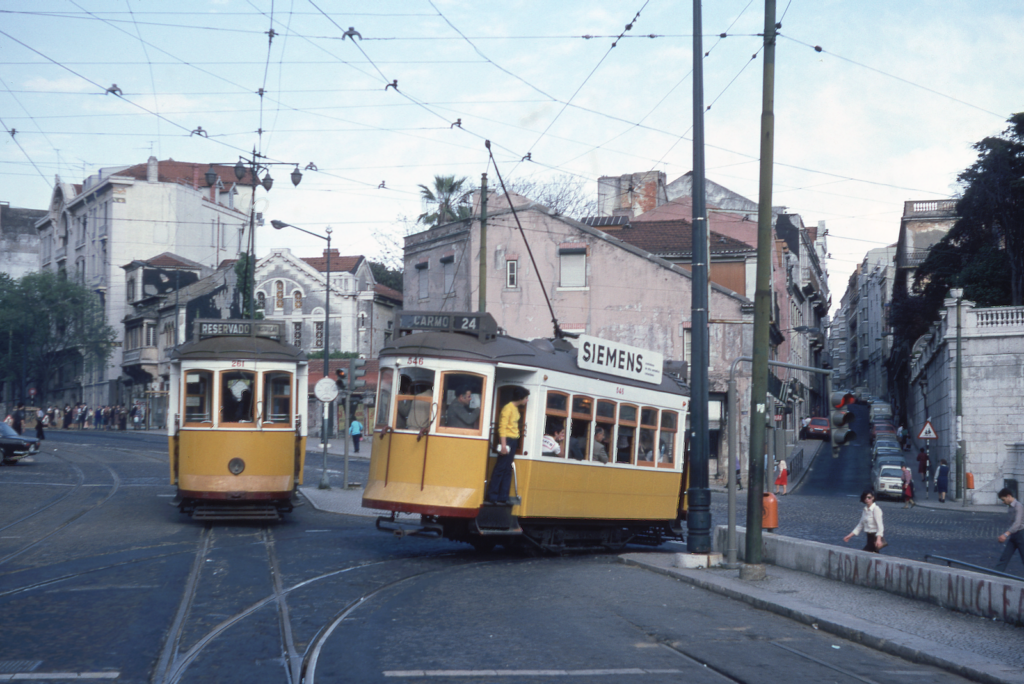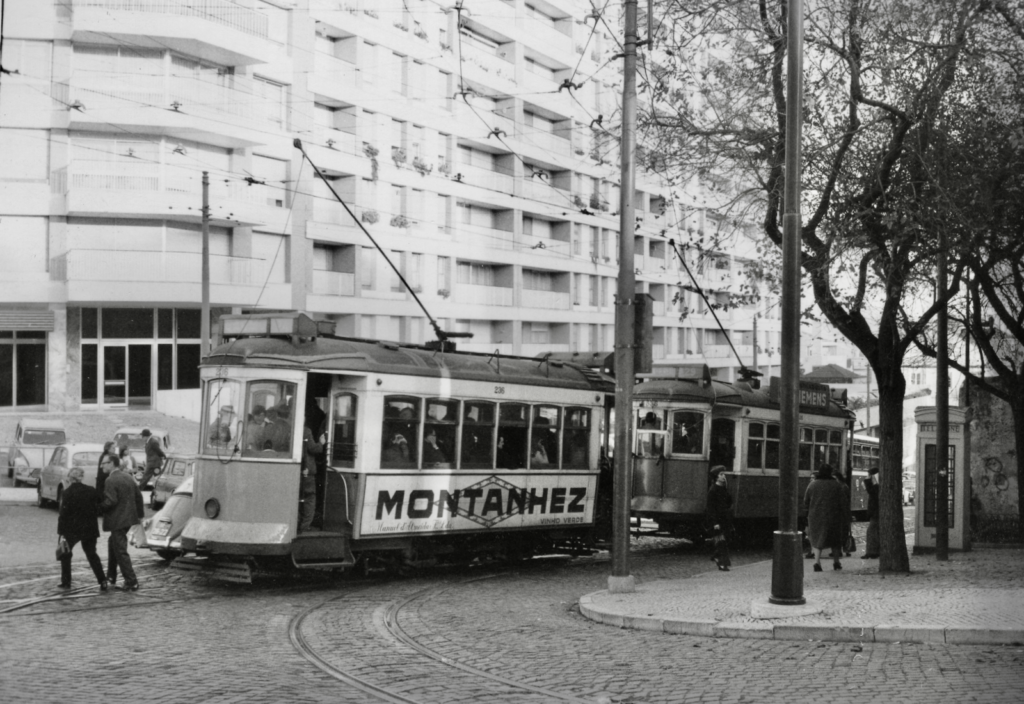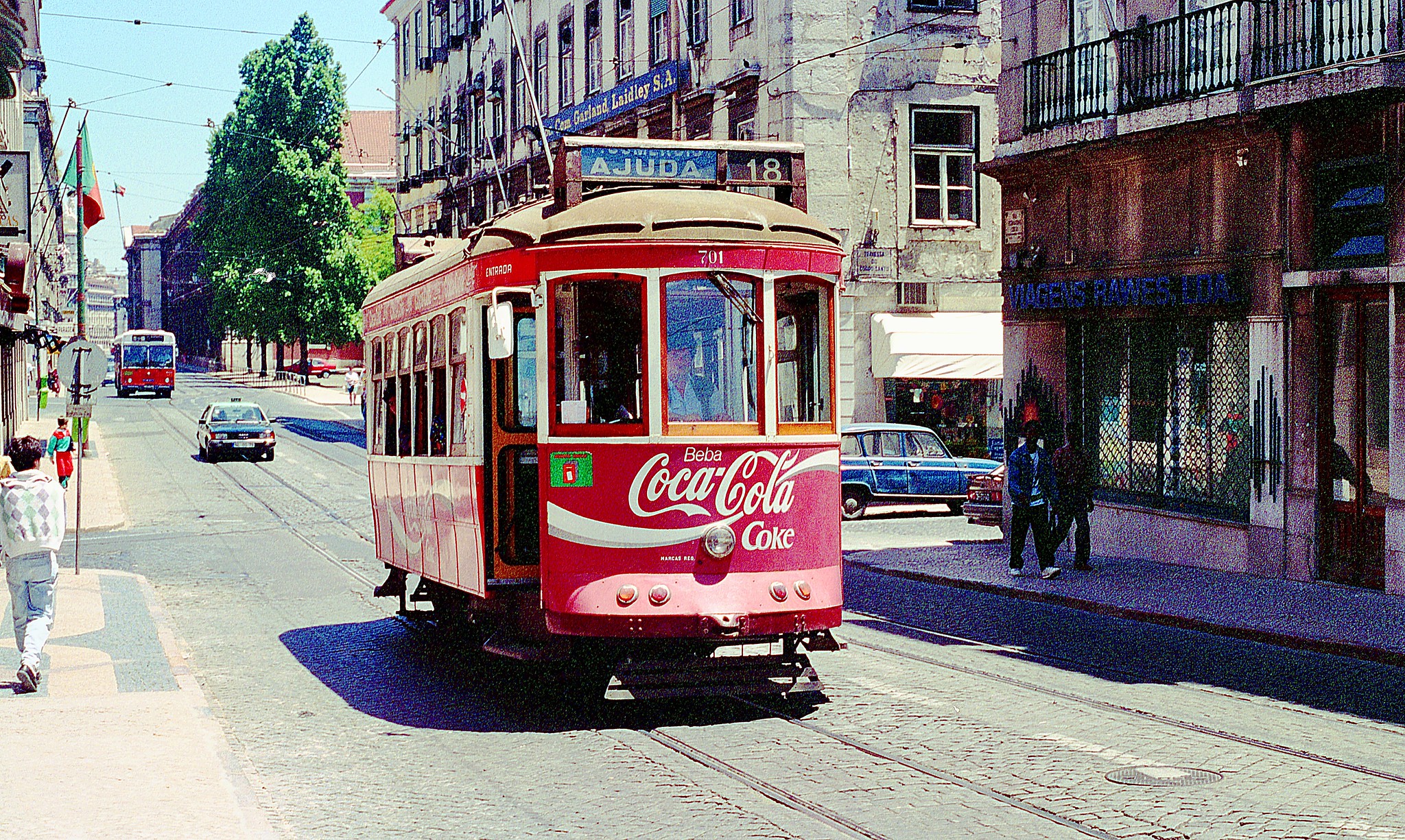While over time many different types of trams ran trough the Lisbon streets, there is one that is emblematic and can be considered as “The Lisbon Tram”. The late John Price introduced in the first edition of the book series “The Tramways of Portugal” for this type the indication “Standard”. This indication was never used within the Carris organization. For Carris it were “Ligeiros”, just as all other two-axle trams. As tram historians and enthusiasts wanted to distinguish the type from the other two-axle trams, with them the indications “Standard” and “plataforma alta” and “meio degrau” for two sub types sticked.

There were in total 165 trams of this type that can be divided in four sub-types. Later more types emerged due to modifications.
The four original sub-types are:
- 20 trams built in 1928 type plataforma alta (high platform) series 532-551.
- 20 trams built in 1931 type meio degrau (medium step) series 552-571.
- 85 trams built 1932-1937 & 1940 with overhauled trucks and motors of disposed old trams, series 203-282 + 415, 455, 467, 468 & 483.
- 40 trams built 1935-1940 allowed to work on lines with the steepest slopes, series 613-617 & 701-735.
| Number | 532-551 | 552-571 | 203-282, 415, 455, 467, 468, 483 | 613-617, 701-735 |
|---|---|---|---|---|
| Overall length | 8.38 m | 8.38 m | 8.38 m | 8.38 m |
| Width | 2.38 m | 2.38 m | 2.38 m | 2.38 m |
| Floor height | 84 cm | 91 cm | 88 cm | 88 cm |
| Platform height | 84 cm | 80 cm | 73 cm | 73 cm |
| Weight | 9.7 t | 9.7 t | 10.3 t | 10.7 t |
| Seats | 24 | 24 | 24 | 24 |
| Standing | 21 | 21 | 21 | 21 |
| Truck | M&T 21ESL | M&T 21E | Brill 21E | M&T 21ESL |
| Wheel base | 1.98 m | 1.98 m | 1.98 m | 1.98 m |
| Wheel ø | 74 cm | 79 cm | 85 cm | 85 cm |
| Motors | 2x MV115 | 2x MV115 | 2x GE59 | 2x MV115 |
| Controllers | GE K10D | Dick, Kerr DB1K3 | GE K10D | Dick, Kerr DB1K3 |
| Wheel brakes | manual, air, 532-535 also rheostatic | manual, air, rheostatic | manual, air | manual, air |
| Track brakes | manual | manual | manual | manual, electro-pneumatic |

Carris had the plan to modify the series 532-551 and 552-571 for working on the steepest slopes, but in the end that only happened to the first four: 532-535. In the first half of the 1950’s part of the trams were changed to single-end for working in semi-permanent combinations with trailers. Now as sub-types existed:
- 4 trams with 21ESL trucks and MV115 motors, type plataforma alta (high platform) allowed to work on lines with the steepest slopes, series 532-535.
- 16 trams with 21ESL trucks and MV115 motors, type plataforma alta (high platform), single-end for working with trailers, series 536-551.
- 20 trams with 21E trucks and MV115 motors, type meio degrau (medium step), series 552-571.
- 18 trams with 21E trucks and GE59 motors, single-end for for working with trailers, series 203-220.
- 67 trams with 21E trucks and GE59 motors, series 221-282 + 415, 455, 467, 468 & 483.
- 40 trams with 21ESL trucks and MV115 motors, allowed to work on lines with the steepest slopes, series 613-617 & 701-735.
The reduction of the number of the trailers in use in the early 1970’s also meant the disposal of the first of the Standards. By 1979 their total numbers had been reduced to 134:
- 3 trams with 21ESL trucks and MV115 motors, type plataforma alta (high platform) allowed to work on lines with the steepest slopes, series 533-535.
- 16 trams with 21ESL trucks and MV115 motors, type plataforma alta (high platform) single-end for working with trailers, series 532-551.
- 17 trams with 21E trucks and MV115 motors, type meio degrau (medium step) series 553-566, 568 and 570-571.
- 58 trams with 21E trucks and GE59 motors, series 221-223, 225-247, 249-252, 254-268, 270, 272-278, 280-282, 415 & 483.
- 40 trams with 21ESL trucks and MV115 motors, allowed to work on lines with the steepest slopes, series 613-617 & 701-735.
During the 1980’s the trams were gradually modified to one man operation. That meant installing of ticket validators and driver controlled doors. In 1984 the circular line 10/11 was combined with line 28 and that required more trams allowed to work on the steepest slopes. However not all existing trams allowed to work the steepest slopes could be modified to one man operation, so part of the trams that could be modified for the latter were also modified to work on the steepest slopes. About 1990 the remaining 104 Standards were of the sub-types:
- 39 trams with 21E trucks and GE59 motors, series 221-223, 225, 227-228, 230, 235-238, 240-247, 252, 254-257, 261-262, 264-267, 270, 272-273, 275, 277-278, 281, 415 & 483.
- 47 trams with 21ESL trucks and MV115 motors, allowed to work on lines with the steepest slopes, series 613-617, 701-735, 737-738 & 741-745.
- 3 trams changed to single-end with 21ESL trucks and MV115 motors, allowed to work on lines with the steepest slopes, series 761-763.
- 15 trams changed to single-end with 21E trucks and MV115 motors, allowed to work on lines with the steepest slopes, series 771-785. These were modified from the trams type meio degrau originally 552-571.
Around 1995 a total of 45 Standards were complete overhauled and got new trucks, motors and other electric equipment. These trams are called Remodelados and make the bulk of the current fleet. Of the other trams about ten were kept by Carris, the others were sold or scrapped.
- 45 trams Remodelados with Ferrostaal trucks and 50 kW Skoda motors, series 541-585. These trams do most of the normal service, seven are allocated to the tourist service.
- About 13 trams with 21ESL trucks and MV115 motors, series 700. These are only used for special services.


Leave a Reply